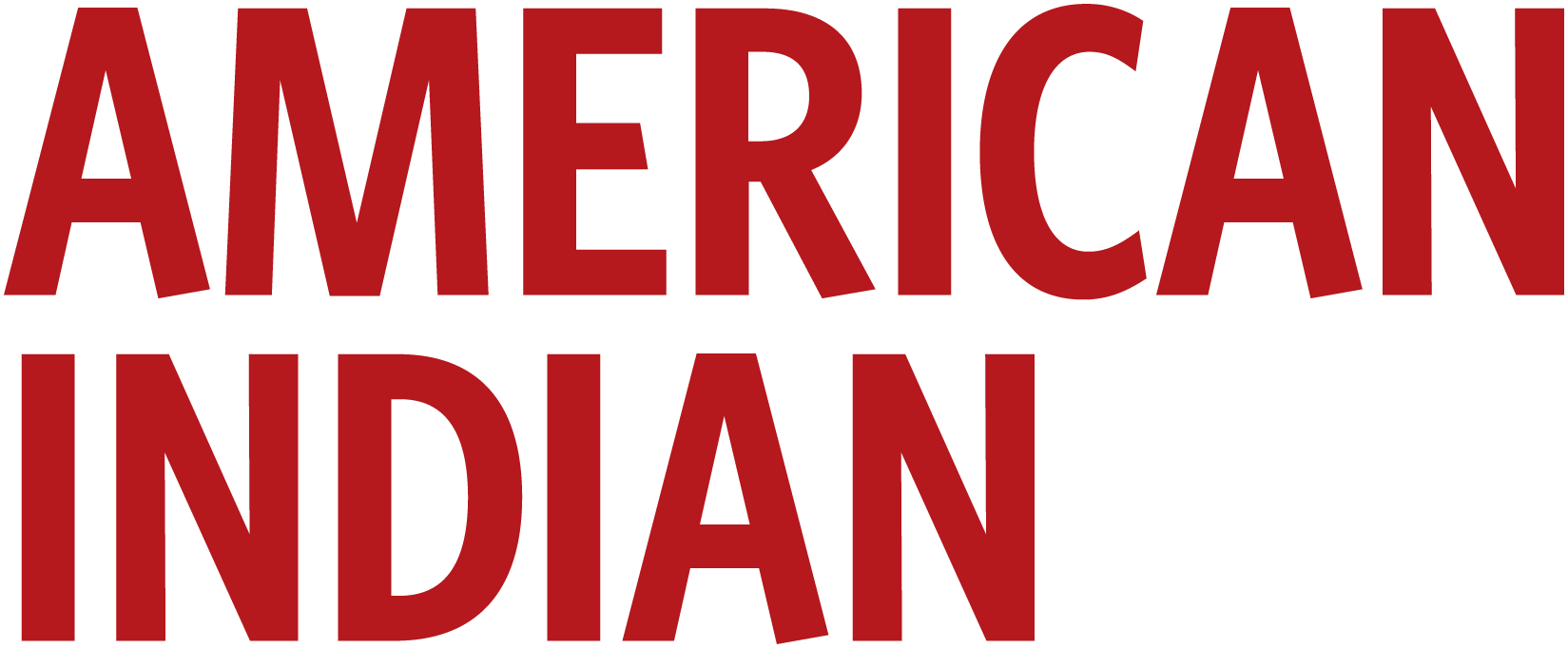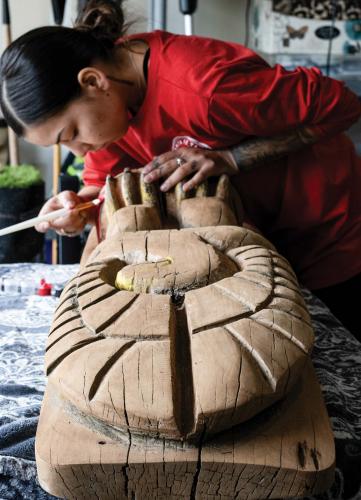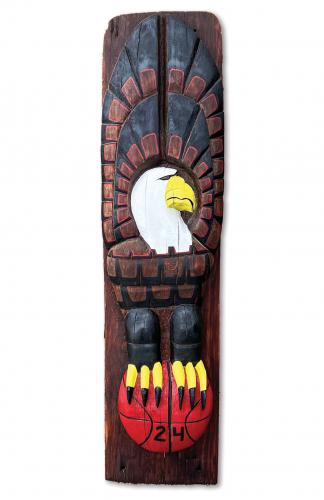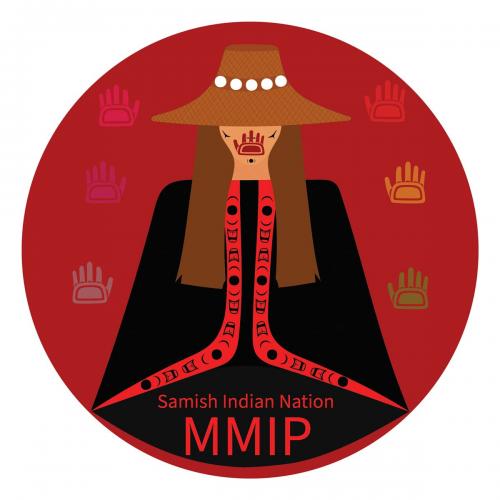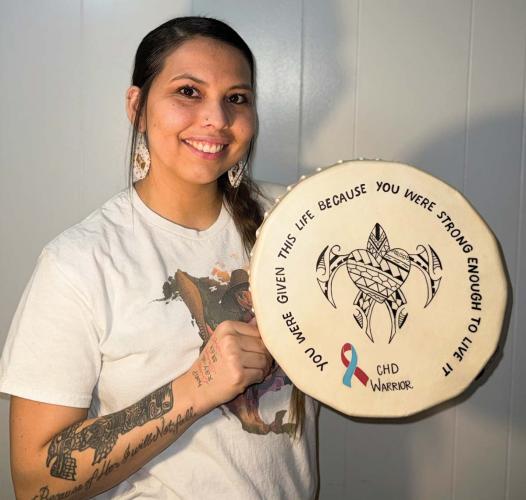Nakesha Edwards and her identical twin sister, Nakiya, are etching their own way in a long path of Swinomish artists. While they were in a wood-carving class in their community’s La Conner High School, they caught the attention of their uncle Kevin “wah lee hub” Paul, a Coast Salish traditional master carver who taught North Pacific Coast Native art at their school. “One of the goals I had was that a tribal member would pick it up, fall in love with it for the art itself and keep it alive,” he said. “I saw there was talent in these two girls, Nakiya and Nakesha. They just excelled. They learned the techniques that I do—how to paint, how to carve.”
In addition to being enrolled members of the Swinomish Indian Tribal Community in northwest Washington state, the sisters have family ties to the Upper Skagit, Samish, Snoqualmie, Yakama and Klamath Tribes. The “formline” art of these and other Coast Salish peoples in the North Pacific Coast of the United States and Canada often have designs made with shapes that are ovoid or that resemble a “U” or “S.” Nakesha and Nakiya use their knowledge of Coast Salish designs to create traditional art. Nakesha also incorporates these designs into various digital works that reflect her heritage. Both artists have used their talents to raise awareness of Indigenous issues or promote well-being.
Porter Swentzel, the chair and a former professor of the Indigenous Liberal Studies Department at the Institute of American Indian Arts (IAIA) in Sante Fe, taught several classes at IAIA that Nakesha attended. Swentzel, who is from the Santa Clara Pueblo in New Mexico, said he learned a lot about Coast Salish style from his student. “From the very beginning, Nakesha really showed a lot of pride in her home community, especially the art tradition. … I was her professor, but she was also mine.”
Nakesha focused on Coast Salish carving for her senior project and after earning a bachelor's in Indigenous Liberal Studies from IAIA in 2021 and a master's of Legal Studies from the University of Oklahoma in 2023, she returned to her community the following year to share her Coast Salish art skills. The timing for Nakesha and the Samish community was perfect: the Samish Indian Nation welcomed her as their new artist in residence at their Beaver Lodge Carving Studio in Anacortes, Washington. The tribe created the studio in 2008 to provide a workspace for local artists and opened it to the public in 2014 to enable artists to share their knowledge.
At the lodge, Nakesha learned from other community artists while practicing her own art. Jackie Ferry, the citizen services senior director and tribal historic preservation officer for the Samish Tribe, said selecting Nakesha was also a win for artists in the community who wanted to come learn about Coast Salish art. “It’s hard to find someone who knows both styles—the more local, regional style as well as the northern style,” she said. “So being able to find somebody who has the skill to do the art and the knowledge behind it and how to advise others if they wanted to create something in a regional style was pretty ideal.”
The experience allowed Nakesha to create and share her art while gaining a closer connection to her extended family and other tribal communities. “Being selected gave me an opportunity to come into the community,” said Nakesha. “I got to know other Coast Salish artists, carvers and people who work on canoes. … I got to meet relatives I hadn’t even known before.”
Though Nakiya feels passionate about her work, she explained she fell into the role of a traditional artist through a bit of a fluke. Because they were twins, when Nakesha left for college, “everyone just assumed I was the one carving. Everyone was contacting me, and it was really for her. I just ended up getting into that role.” Nakiya has since created various artworks, from traditional drums and plaques to restoring “story poles” that tell a tribe’s origin.
Since Nakesha returned to her home community in 2024, she has incorporated her heritage into many digital works, including logos for the Swinomish Indian Tribal Community and Samish Indian Nation, the latter to raise awareness about missing and murdered Indigenous people. She wishes to help others, both in her job as the mental health program manager working to develop programs for youth and as an artist.
Now, Nakesha and Nakiya have worked collaboratively. They painted wooden plaques with four out of the five traditional salmons in the Salish Sea for each of the four main conference rooms in the Skagit Public Utility District’s newest building. “I just love the idea of us creating together,” Nakiya said. Her sister’s kindness, she said, “makes my heart warm. I look up to her.”
Nakesha is in the process of carving and painting plaques with motivational messages for the Swinomish’s Didgwálič Wellness Center. She hopes her designs might one day be on clothes or book covers, but her “ultimate goal” is to carve a totem pole. “I would love it if my uncle Kevin could help guide me through that. I did restore my grandfather’s funerary totem pole. Now I want to be able to start from top to bottom, the whole process.”
Paul said he was inspired by Nakiya and Nakesha’s passion for their ancestral artforms. He told them, “You have to find your own feel for it and not to be in love with it for just money. I feel in my heart seeing the success that they’re having, and it makes me feel wonderful.”
